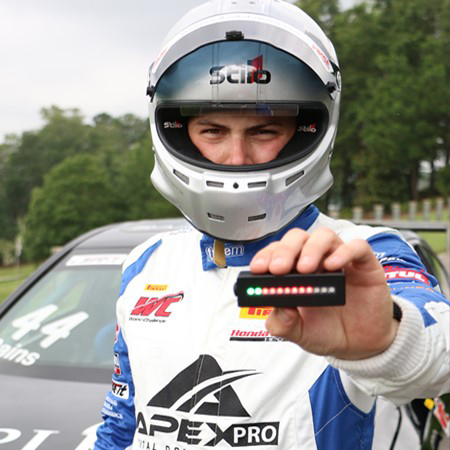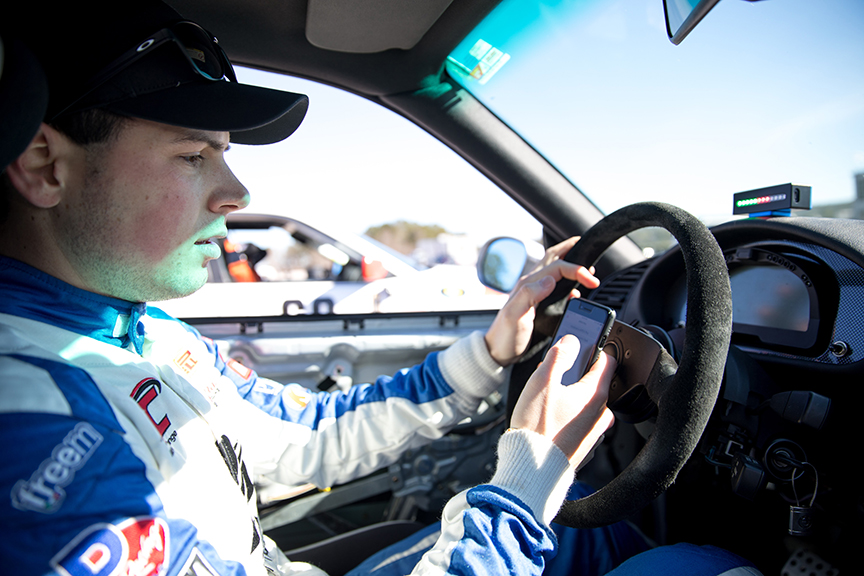
“Even in this age of machine learning, humans ultimately still make the decisions –
on the race track and in the board room. That means they must be able to interpret
the data and follow up with action. It’s up to the user to decipher the data they
are provided ..."”
You mash the gas pedal and torque associated with rapid acceleration quickly pushes
your body backward into the seat. Objects to your left and right become a blur. You’re
at top speed, and frankly, it’s quite a rush.
A hairpin corner approaches. Decisions must be made. How hard should you brake? What’s
the best angle to take the corner without compromising speed? A wrong decision here
could spell disaster.
 Drivers need to fully understand what their vehicle can and can’t do in order to make
such decisions. Andrew Rains, who earned a marketing degree in 2015 from the Harbert College of Business, has developed a device – APEX Pro – that relays real-time data back to motorsports enthusiasts to help them not only
understand what they are capable of but learn from this information in order to make
better decisions down the road.
Drivers need to fully understand what their vehicle can and can’t do in order to make
such decisions. Andrew Rains, who earned a marketing degree in 2015 from the Harbert College of Business, has developed a device – APEX Pro – that relays real-time data back to motorsports enthusiasts to help them not only
understand what they are capable of but learn from this information in order to make
better decisions down the road.
“Even in this age of machine learning, humans ultimately still make the decisions
– on the race track and in the board room,” said Rains, whose device sells for $450
and is the only product on the market that conveniently relays information from sensors
via Bluetooth directly to a user’s cell phone. “That means they must be able to interpret
the data and follow up with action. It’s up to the user to decipher the data they
are provided, whether it’s an analysis of where he or she should have braked sooner,
gotten back into the throttle later, or in the business world, explore where customer
service can be better directed.
 “Everyone gets something different out of the data they receive, and ultimately, people
see what they want to see in the data. That’s very difficult because of our natural
vices in life and backgrounds to see what the data really is, or how it should be
interpreted. And as a driving coach, that’s a challenging thing to teach.”
“Everyone gets something different out of the data they receive, and ultimately, people
see what they want to see in the data. That’s very difficult because of our natural
vices in life and backgrounds to see what the data really is, or how it should be
interpreted. And as a driving coach, that’s a challenging thing to teach.”
How does it work? APEX Pro is a one-inch tall by four-inch long piece of hardware
that mounts on the dash of the car and uses GPS and accelerometers inside the device
to measure the accelerations/decelerations the car is experiencing. “It inputs all
of the data into a vehicle dynamics model, a physics model,” Rains said. “What’s different
about us is we use a nine-axis accelerator. Uphill, downhill, flat, proprietary, etc.
That’s what tells you if you can brake deeper.”
Rains was a racing enthusiast long before he envisioned APEX Pro, which won the $100,000
grand prize at the 2018 Alabama Launchpad entrepreneurship competition. The Birmingham native enjoyed a successful stint as a driver and team owner as a
college student, competing in a number of SCCA-sanctioned endurance events from Barber
Motorsports Park, Road Atlanta, to Laguna Seca. He even recorded a pair of podium
(top three) finishes last year.
 What do successful race car drivers do as soon as they climb out of their cars? In
many cases, they reach for a cold soft drink. You’ve probably done that a time or
two this week as well. But soft drink bottles don’t just wind up in vending machines
by accident, nor are they magically placed on your favorite grocer’s aisles. It’s
a multi-faceted process, and a big part of that process involves recording real-time
data. Sodas don’t need to brake at 90 mph or fully understand what apex to take the
next twist in the road, but professionals in the industry track information provided
by sensors in vending machines and on the manufacturing warehouse floor that help
that can of soda be the best can of soda it can be.
What do successful race car drivers do as soon as they climb out of their cars? In
many cases, they reach for a cold soft drink. You’ve probably done that a time or
two this week as well. But soft drink bottles don’t just wind up in vending machines
by accident, nor are they magically placed on your favorite grocer’s aisles. It’s
a multi-faceted process, and a big part of that process involves recording real-time
data. Sodas don’t need to brake at 90 mph or fully understand what apex to take the
next twist in the road, but professionals in the industry track information provided
by sensors in vending machines and on the manufacturing warehouse floor that help
that can of soda be the best can of soda it can be.
The next time you stand in front of a soda vending machine, consider the amount of
artificial intelligence inside. Other than simply popping out a Coke Zero, such machines
have enough brainpower via sensors to detect issues like temperature drops, electricity
failures, coin jams, bottle jams, low product, etc. This information is relayed back
to the bottler, who can begin resolving the issue.
“The sensors inside these machines are just like the check engine light in your car,”
said Steve Mann, IT Systems Manager at Coca-Cola Consolidated in Charlotte, North Carolina, for the past 17 years who earned a degree in information systems management from the Harbert College of Business in 1991.
“The types of sensors regulate temperature (38 degrees is desired), electricity, whether
the lights are on or off outside the machine, and does product rotation inside the
machine for us. As with any type of sensor, you can key the code and get back the
information that tells you what’s wrong. Some machines can even call home and report
that information based on what you want to monitor.”
Whereas much data comes in the form of surveys or sales reports and allows management
to make decisions for a company, sensors within machines in the manufacturing sector
talk to one another. Data provided from one sensor provides information needed for
another machine to perform a task. In the beverage industry, sensors insure that products
are blended with the precise measure of ingredients and concentrate.
“If it’s a recipe and I’m blending a beverage into a specific sized container, I’ve
got to have this much concentrate, this much sugar, this much water, and so on, to
mix at a certain temperature and then create your finished good.
 “Once you release a wave of orders to the warehouse floor, sensors are not only picking
up the UPC codes, but also all of the dimensions associated with it to make sure it
can ship the product on the right order to assemble it on the correct pallet. Machine
learning is so important here because all of those dimensions and information is used
by the machines to make sure that you pack a stable pallet that can be delivered on
a truck to a customer and then you can easily unload it and put it into a cooler or
on the shelves.”
“Once you release a wave of orders to the warehouse floor, sensors are not only picking
up the UPC codes, but also all of the dimensions associated with it to make sure it
can ship the product on the right order to assemble it on the correct pallet. Machine
learning is so important here because all of those dimensions and information is used
by the machines to make sure that you pack a stable pallet that can be delivered on
a truck to a customer and then you can easily unload it and put it into a cooler or
on the shelves.”
Whereas machine learning nearly spelled the end of humanity in the “Terminator” series,
Mann reminded that professionals continue to monitor system performance, from the
vending machines to all products on the warehouse floors.
“There are lots of dashboards and results that keep track of the quality that we are
putting out,” he said. “We want to make as much as we can without having to waste
anything. But machines help take the human error out. Data today is providing information
that allows us to ask, ‘Are we running the right products at the right time?’ to ‘Are
we producing it as quickly as we can?’ and ‘Is there a better way to not only produce
this product in Location A, but maybe we should be producing it in a different manufacturing
facility, or maybe we should add a production line to help offset things.’ With all
of the data run through systems today, there are plant managers and line specialists
looking for better ways to make things more efficient. You have to be able to react
to this data.”
“Data today is providing information that allows us to ask, ‘Are we running the right
products at the right time?’ to ‘Are we producing it as quickly as we can?’ ..."”
Should data received, either via sensors or financial reports, always be adhered to?
“When you ignore the data, just like in any business, and you’re making decisions
based off of customer information, reports, or surveys, there has to be an element
of intuition,” said Rains. “Customers are saying this, the board wants this, and investors
are telling you this. But if you’re in the seat and you have to make the decisions
– then you have to aggregate that information and not just go with what you think
or feel is best. That’s exactly how we work on the race track. We use the data as
one element. But as a driving coach, I use it to support what I want to communicate
to the drivers. The other half is … are they actually going to do it?”
Though machine-learned data is vital to production on the manufacturing floor, Mann
insists that data provided to board rooms is equally important to the non-machines
(executives) running companies.
“A lot of executives get daily sales reports that tell them what was budgeted based
on what pricing was and think of it more of a stock market of sales. It helps them
to make better decisions."”
“A lot of executives get daily sales reports that tell them what was budgeted based
on what pricing was and think of it more of a stock market of sales. It helps them
to make better decisions,” Mann said with assurance. “Did we push the right products?
Do we have the right price points in the field? Are we going after the market the
right way? They can see what they forecasted, planned and priced versus what actually
took place.
“Those reports have become critical for executives to make decisions and validate
the decisions that they made. Business teams have come up with their own analytics
teams because they are trying to analyze the data more and more than in the past.
They can turn around and be more self-sufficient with data provided to them. Am I
serving the customer the right way, not just selling the product? It’s responding
to their issues, it’s responding to equipment repairs or services they need, complaints.”
But don’t over-analyze.
“If you are trying to record every single decision you make or action you take, in
business or in racing, and aggregate all of that data constantly – you’re going to
end up with data overload and make poor decisions.”


 Degrees & Programs
Degrees & Programs
 Faculty & Staff
Faculty & Staff
 Career Development
Career Development
 Recruiters & Industry
Recruiters & Industry

 Drivers need to fully understand what their vehicle can and can’t do in order to make
such decisions. Andrew Rains, who earned a
Drivers need to fully understand what their vehicle can and can’t do in order to make
such decisions. Andrew Rains, who earned a  “Everyone gets something different out of the data they receive, and ultimately, people
see what they want to see in the data. That’s very difficult because of our natural
vices in life and backgrounds to see what the data really is, or how it should be
interpreted. And as a driving coach, that’s a challenging thing to teach.”
“Everyone gets something different out of the data they receive, and ultimately, people
see what they want to see in the data. That’s very difficult because of our natural
vices in life and backgrounds to see what the data really is, or how it should be
interpreted. And as a driving coach, that’s a challenging thing to teach.” What do successful race car drivers do as soon as they climb out of their cars? In
many cases, they reach for a cold soft drink. You’ve probably done that a time or
two this week as well. But soft drink bottles don’t just wind up in vending machines
by accident, nor are they magically placed on your favorite grocer’s aisles. It’s
a multi-faceted process, and a big part of that process involves recording real-time
data. Sodas don’t need to brake at 90 mph or fully understand what apex to take the
next twist in the road, but professionals in the industry track information provided
by sensors in vending machines and on the manufacturing warehouse floor that help
that can of soda be the best can of soda it can be.
What do successful race car drivers do as soon as they climb out of their cars? In
many cases, they reach for a cold soft drink. You’ve probably done that a time or
two this week as well. But soft drink bottles don’t just wind up in vending machines
by accident, nor are they magically placed on your favorite grocer’s aisles. It’s
a multi-faceted process, and a big part of that process involves recording real-time
data. Sodas don’t need to brake at 90 mph or fully understand what apex to take the
next twist in the road, but professionals in the industry track information provided
by sensors in vending machines and on the manufacturing warehouse floor that help
that can of soda be the best can of soda it can be. “Once you release a wave of orders to the warehouse floor, sensors are not only picking
up the UPC codes, but also all of the dimensions associated with it to make sure it
can ship the product on the right order to assemble it on the correct pallet. Machine
learning is so important here because all of those dimensions and information is used
by the machines to make sure that you pack a stable pallet that can be delivered on
a truck to a customer and then you can easily unload it and put it into a cooler or
on the shelves.”
“Once you release a wave of orders to the warehouse floor, sensors are not only picking
up the UPC codes, but also all of the dimensions associated with it to make sure it
can ship the product on the right order to assemble it on the correct pallet. Machine
learning is so important here because all of those dimensions and information is used
by the machines to make sure that you pack a stable pallet that can be delivered on
a truck to a customer and then you can easily unload it and put it into a cooler or
on the shelves.”


